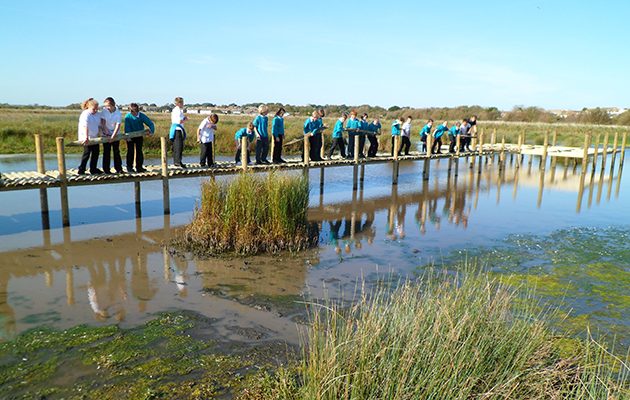Mike Fairclough, head teacher at a junior school in Eastbourne, explains how including countryside management in the curriculum can have both an academic and environmental impact
West Rise Junior School has made countryside management part of their curriculum. The school, which is the highest performing in the area and in the top 5% nationally, has a small farm and the children look after beehives, learn to fire shotguns and air rifles and regularly prepare, cook and eat game. Headteacher Mike Fairclough explains why teaching countryside management is crucial, both academically and environmentally.
The future of fieldsports is in the hands of the next generation. Enthusing and encouraging youngsters is key, but when should they start shooting? Read what age should youngsters start shooting?
WEST RISE JUNIOR SCHOOL
Educating children about countryside management is not compulsory for schools but I believe it should be. Since becoming the head teacher of West Rise Junior School in Eastbourne 14 years ago, my team and I have embraced the great outdoors. We have a small farm, which is home to chickens, goats, sheep, alpacas and a herd of six water buffalo. The school is located on a council estate, where most of our children come from, and is adjacent to a 120-acre piece of marshland, which we lease from the local authority. On this land, our children are taught to light and cook over an open fire, identify the local fauna and flora and forage for food. Using knives, bow saws and hand drills, they make items out of wood, such as jewellery, wooden mallets, whittled sticks and shelters. We also have several beehives on the marsh, which the children look after.
Working with BASC and the Countryside Alliance, the children, aged seven to 11, are taught to fire shotguns and air rifles and about the law pertaining to firearms. BASC has also taught them about ferreting, using gundogs and how to shoot pigeon. Farm manager Alex Richards teaches them how to prepare game, including skinning rabbits and plucking birds, which they then cook and eat outside. These experiences would not be readily accessible to most of our children as there is high socio-economic deprivation on the estate.
Academically, it is the highest performing school in Eastbourne and in the top 5% nationally, within aspects of the core curriculum. We attribute this success to the fact that the children love coming to school and the vast majority acquire grit and resilience through being outside for long periods.
We are fully supported by our parents, the local authority, the Health and Safety Executive and Ofsted. Additionally, the mainstream media regularly celebrates the outdoor learning at the school. We have been on BBC’s Countryfile, Blue Peter, BBC TV news, GMTV and in every major British newspaper. A recent Channel 4 news item endorsing the school has had 16 million views on Facebook to date.
However, not everyone agrees with our approach. Some people believe that exposing children to hunting and shooting is wrong. These individuals also say that it is unnecessary to shoot rabbits, pigeon and grey squirrels. This is where my belief that countryside management should be part of the National Curriculum comes from. I don’t judge the people who criticise my approach because I realise that their beliefs stem from a lack of education about the countryside. There are also those who feel that children should not be exposed to death. However, the vast majority of people across the world embrace what we do.
In addition to the positive academic impact, learning outdoor skills also educates children about the lifecycle, food chain, economics of the countryside, responsible use of firearms and equips them with vital character traits, such as endurance and perseverance. Most importantly, the children grow to understand the need to manage the countryside and how this is carried out.
My two sons, who attended the school a few years ago, both shoot and provide the family with rabbits and pigeon for the pot. This is where I intend to take the project next. The pupils at the school have only shot clays and never shot a live pigeon. Given that many of them have prepared and cooked game, this seems to be a logical progression.
I will continue to promote this approach to other schools. TES [formerly the Times Educational Supplement] awarded the school “Primary School of the Year” in 2015 on account of our outdoor learning provision. TES supported the school when we first started shooting and has continued to do so. I recently became a columnist for the magazine, which will act as an additional platform for my approach. I’ve written a book, Playing With Fire: Embracing Risk and Danger in Schools, which many schools now refer to and is on the reading list of two teacher-training universities in the UK.
Finally, I will continue to work with the mainstream media. I frequently receive messages from fellow head teachers, who have developed their outdoor learning programmes as a result of seeing my school in the press or from reading my book. There is a real momentum within education for this approach; change is definitely happening.
Of course, countryside management sits within a much broader context than education alone. The billions of pounds it contributes annually to the UK economy is an under-celebrated fact. The jobs it provides and its contribution to British cultural heritage is undervalued. Again, this is why countryside management needs to be on the curriculum. Until that time, we will continue to educate the children at my school and promote the approach to others, regardless of the inevitable criticism from those who have yet to learn accurately about the countryside.





